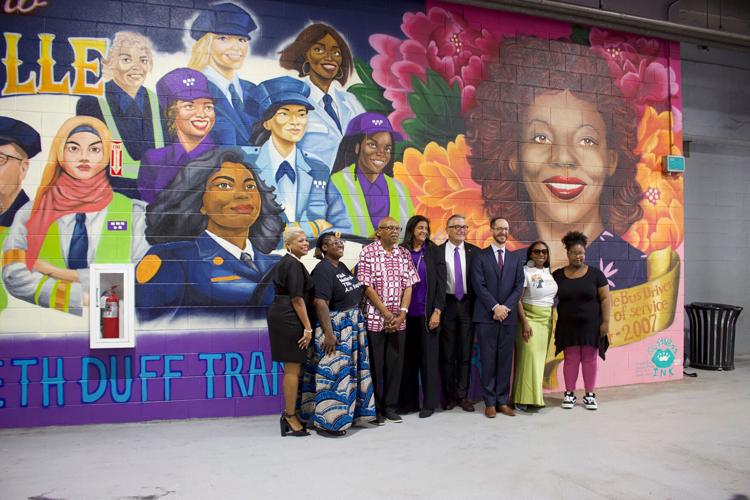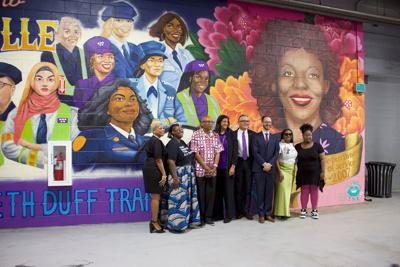Elizabeth Duff was a trailblazer. In 1974, at age 24, she became the first woman to drive a bus for what was then known as the Metro Transit Authority in Nashville.
Nashville’s public transit authority rebranded itself as WeGo in 2018, and the city’s WeGo Central station already bears Duff’s name. But earlier this month, Duff — who died in 2021 at age 72 — was honored with a mural on the station’s lower level, thanks to artists from local nonprofit Creative Girls Rock.
“I thank God for Elizabeth and my daughters and granddaughters — I’ve got quite a few of them,” said Elizabeth’s widower Harry Duff at the event. “I think about them and where they’re going to go, but I don’t worry about them because they’ve got something to go by. They’ve got Elizabeth Duff to look up to. They can look at Elizabeth’s life and pattern their lives after that and know which route to take.”
Mayor’s $3.1 billion transit plan focuses on buses, sidewalks, transit centers and traffic signals
Mayor Freddie O’Connell spoke at the ceremony on Sept. 12 — the same day his office unveiled a website feature that displays specific changes to routes under his proposed “Choose How You Move” plan. O’Connell asked attendees to “meet the moment” and vote for the transit referendum on the Nov. 5 ballot. He added that WeGo ridership had recently surpassed pre-pandemic levels.
“I can’t think of a better message for this time and this place than leveraging the story of Music City’s rich heritage and diverse communities to celebrate our differences and strengths,” he said, “to inspire the riders who come through here, the operators who serve them, and to empower young girls and women through creative art.
“This is also a time to think about the future,” the mayor continued. “About how we invest in better transportation options that emanate not just from this center, but those like Rip Patton and Green Hills through our Choose How You Move program.”
The mural is incredibly detailed, and features a portrait of Duff completed by Maplewood High School senior Kammarah Stevens, who worked on each of the many faces in the mural. Spanning several bus-lengths, the mural also includes artistic renderings of the Ryman Auditorium, the Parthenon, the Tennessee State Capitol and the Adventure Science Center.
Artist Elisheba Israel Mrozik, who led students of Creative Girls Rock on the piece, hopes people stop and look for the many Easter eggs she’s hidden.
WeGo says the transit center — set to open this spring — is currently ‘80 percent finished’
“Elizabeth Duff inspired me to find others in the industries of service work and also highlight things in the mural that we may not think about,” Mrozik tells the Scene. “We think about Broadway all the time. But did you know about Frederick Douglass coming here to speak? Did you know that Martin Luther King came to speak? Did you know that the Talking Heads had a random concert at this place? We are just trying to highlight things about Nashville that you don’t find anywhere else.”
Creative Girls Rock has now completed 13 murals and seen more than 160 young women participate in the program, founder Charmin Bates adds.
“We use these mural projects as educational components,” Bates says. “They are learning the different colors and meaning behind colors and art and paint and all of that, just to empower our young artists and to say, ‘You can do this’ as well.”
The mural also features two of Duff’s family members, looking out the window of the bus she’s driving: her son Seneca Duff and grandson Emmanuel Smith Duff. The two have both joined what Elizabeth made the family business — driving a WeGo bus.
Seneca has memories of riding the bus his mother drove as a child — sometimes from point A to point B, and sometimes tagging along for an entire route. When Seneca turned 21, Elizabeth suggested he follow in her footsteps. At first, he wasn’t sure if he could handle working with the public. He eventually started the job at age 24 in 2005. Nearly 20 years later, he’s still on board and looking toward retiring in the next five to 10 years, he tells the Scene.

Emmanuel Smith Duff (left) and Seneca Duff
He says he tries to embody his mother’s friendly nature while dealing with bus riders.
“She had always wanted to drive the bus,” Seneca says. “And she ended up doing it. She’s definitely a trailblazer. She definitely gave me the courage to actually step forward and do the job.”
Emmanuel Smith Duff worked for WeGo two years ago for a stint and rejoined as a driver earlier this year, also at his grandmother’s suggestion. This time it’ll stick, he says — and not only because his face is painted on the wall of the Elizabeth Duff Transit Center.
“When I first started, I didn’t know if I would like driving the bus because I was always intimidated by it,” he says. “But once I started getting it, I caught on to it quick. Maybe when she was trying to tell me that I should drive the bus, I should have listened to her the first time.”









